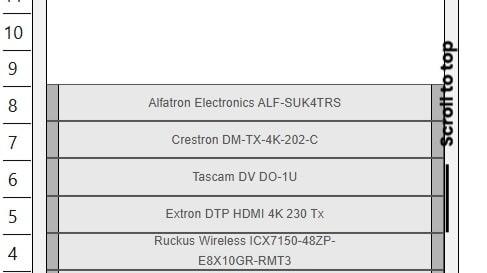How do I choose rack diagram software for data centre infrastructure?

In the fast-paced world of modern IT, data centres form the backbone of digital infrastructure. From cloud computing to enterprise storage and network management, data centres depend on efficient planning, clear visualization, and seamless documentation. One of the most critical tools that support this process is rack diagram software. Whether you are designing new server rooms, upgrading network infrastructure, or managing large-scale facilities, having the right rack diagram software makes a significant difference in performance, accuracy, and maintenance.
This blog explores how to choose the best rack design software for your data centre infrastructure in 2025, highlighting essential features, selection factors, and why specialized tools like those provided by XTEN-AV can elevate your design workflow.
Understanding Rack Diagram Software for Data Centres
Rack diagram software allows engineers and IT professionals to create visual representations of server racks and related equipment within a data centre. It is used to map the physical arrangement of servers, switches, routers, UPS units, and other components in a rack enclosure.
Unlike generic drawing tools, rack design software is tailored for data centre layouts and includes standardized dimensions, device libraries, and connectivity visualization. These tools enable professionals to:
-
Plan space utilization efficiently.
-
Ensure proper cable management and airflow.
-
Simplify maintenance by offering accurate, up-to-date documentation.
-
Improve coordination between IT, facility, and operations teams.
When you have a well-planned rack diagram, you reduce risks of overheating, network failure, or power imbalance, ultimately ensuring better uptime and efficiency.
Why Choosing the Right Rack Design Software Matters
Selecting the best rack design software is not just about drawing or layout capability. It is about finding a platform that integrates into your operational ecosystem.
The right software helps you:
-
Save time by automating repetitive design tasks.
-
Maintain accuracy through predefined templates and libraries.
-
Plan scalability for future data centre expansions.
-
Ensure compliance with industry standards like ANSI/EIA-310 and TIA-942.
-
Support collaboration between multiple teams or locations.
As data centres evolve to support hybrid IT models, the ability to visualize both physical and logical systems in one tool becomes crucial.
Key Factors to Consider When Choosing Rack Diagram Software
Let’s explore the most important aspects you should evaluate before investing in a rack diagram solution.
1. Library of Predefined Components
A good rack design software must include an extensive and regularly updated library of hardware from major manufacturers. These components should include accurate dimensions and specifications, so your rack layouts reflect real-world physical constraints.
2. Ease of Use and Learning Curve
Whether you are a data centre architect or a network engineer, ease of use is essential. A clean interface, drag-and-drop functionality, and guided design workflows help new users get started quickly while ensuring accuracy for experienced designers.
3. Integration with Other Tools
Integration with asset management, network monitoring, and facility management tools adds real value. The ability to synchronize data between your rack diagram and IT inventory systems can prevent mismatches and improve efficiency.
4. Collaboration and Cloud Support
Modern rack diagram tools should enable multiple users to work on the same project simultaneously. Cloud-based collaboration ensures everyone is working on the latest version, reducing design conflicts and version control issues.
5. 2D and 3D Visualization Options
2D diagrams are useful for documentation, but 3D visualization helps in understanding space utilization, cable routing, and airflow paths. Having both options in your rack design software provides flexibility depending on project requirements.
6. Reporting and Documentation Features
The ability to generate professional reports, parts lists, and power summaries is essential for operations and auditing. The software should automatically pull data from the diagram to create these documents without manual entry.
7. Scalability and Customization
If you manage multiple facilities, the software must scale with your needs. Look for tools that allow customization of templates, device databases, and user permissions to suit different project sizes or team structures.
8. Pricing and Licensing Model
Evaluate the total cost of ownership, including license type (subscription or perpetual), number of users, and available support services. The ideal software offers flexible pricing that aligns with your business growth and project volume.
Comparing Different Rack Design Software Options
When selecting rack diagram software, you’ll find a range of solutions catering to different levels of complexity and budget.
-
Entry-Level Tools: These include simple drag-and-drop applications with basic device libraries. They are suitable for small teams but may lack collaboration and automation features.
-
Mid-Tier Software: Tools in this category offer a balance between functionality and affordability, providing good visualization options, moderate integration support, and reporting features.
-
Professional Solutions: High-end platforms like those used in enterprise data centres offer detailed 3D modeling, live data synchronization, and real-time monitoring integration.
XTEN-AV, for example, focuses on professional-grade AV and IT design tools that deliver automation, collaboration, and precision—all essential in modern infrastructure projects.
XTEN-AV and Smart Rack Design
XTEN-AV provides advanced design automation tools tailored to the AV and IT industries. While it specializes in audio-visual system design, its approach and platform capabilities demonstrate what next-generation design tools can achieve in rack planning.
With a focus on speed, accuracy, and cloud collaboration, XTEN-AV’s platform reflects how the future of rack design software should operate—where manual drafting is replaced by AI-assisted modeling and real-time updates ensure designs stay aligned with operational data.
By drawing inspiration from such advanced tools, IT professionals can streamline data centre documentation, reduce design errors, and improve overall system performance.
Tips to Get the Most Out of Your Rack Diagram Software
-
Standardize Naming Conventions: Maintain consistency across all rack layouts to avoid confusion during maintenance.
-
Use Templates for Repeated Setups: Many data centres have repetitive rack configurations. Templates save time and ensure consistency.
-
Regularly Update Component Libraries: Ensure your design tool’s database includes the latest equipment models.
-
Train Your Team: A short training session can improve efficiency significantly, especially when switching to new tools.
-
Leverage Automation: Use automatic cable routing, power load calculations, and device placement to eliminate manual errors.
Conclusion
Choosing the right rack diagram software for your data centre infrastructure requires a balance between functionality, scalability, and budget. With increasing complexity in IT environments, tools that combine precision, collaboration, and automation are essential.
Whether you are managing a single rack or a large facility, investing in capable rack design software ensures efficient planning, smooth deployment, and simplified maintenance.
XTEN-AV continues to represent how intelligent design tools can evolve beyond traditional limitations—offering professionals the ability to visualize, document, and manage complex systems more efficiently than ever before.
- Art
- Causes
- Best Offers
- Crafts
- Dance
- Drinks
- Film
- Fitness
- Food
- Jogos
- Festival
- Gardening
- Health
- Início
- Literature
- Music
- Networking
- Outro
- Party
- Religion
- Shopping
- Sports
- Theater
- Wellness



